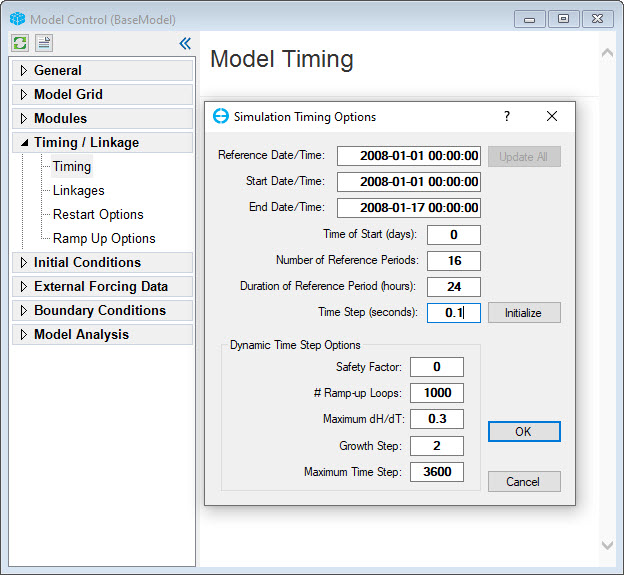Simulation Timing Options
The simulation timing options for EE10 are shown in Figure 1. RMC on Timing in Timing/Linkage menu item to edit the model timing.
In this form, specify the time to start and end the run, along with the time stepping options and duration of the period. The Reference Date/Time (also known as the Base Date) is the time from which all Julian days are counted. Time of Start is the number of Julian days, relative to the Reference Date/Time, at which to begin the simulation. Changing the Time of Start will automatically update Start/Date Time. The End Date/time is calculated by adding the Number of Reference Periods to the Start Date/time. The Duration of Reference Period is used to define a project-specific meaningful period. This is often set to 24 hours to select a one day long reference period. The duration of the simulation is then set by specifying the number of reference periods. Other important options include:
- The Time Step should be at least an order of magnitude below the CFL Time Step. An initial value can be suggested by clicking the Initialize button. If fixed time-steps are used, this value will be used for the whole run. If dynamic time stepping is being used, then the time step can be seen as an initial or minimum time step, as EFDC+ will use multiples of this value.
- The Dynamic Timestep Options sub-frame allows the user to engage auto stepping by setting the Safety Factor to a positive number >0 and <1. Generally, the safety factor ought to be less than 0.8, but some runs work with a safety factor >1, and some require a value <0.3. If set to 0, it will result in fixed time steps.
For the model with the dynamic time step option, the EFDC+ calculates the required minimum time step by combining the three methods below:
- Method 1: based on Courant–Friedrichs–Lewy condition
- Method 2: based on Positivity of advected material (when the model includes one of temperature, salinity, dye, etc. module)
- Method 3: based on Limit rate of depth change
- The final time step is chosen as the minimum of the three methods for all the grid cells, then multiplied by the Safety Factor.
- It should be noted that the initial time step is usually set by a small value. Then, this initial time step will be updated over time during the model simulation based on the dynamic time-stepping process described above.
- The number of Ramp-Up Loops should also be set by the user; this is the number of initial iterations for which to hold the time step to a constant value during ramp-up.
- The Maximum dH/dT option is ignored if set to zero, but if >0, then EFDC (CALSTEP routine) will use these additional criteria to set the dynamic timestep.
- Growth Step is the minimum number of iterations for each time step before increasing the time step for the dynamic time stepping (DTDYN in C7 of EFDC.INP).
- Maximum Time Step is the maximum allowed time step in seconds. If this value is too high, the model will crash.
Figure 1. Timing/Linkage menu: Model Timing.
